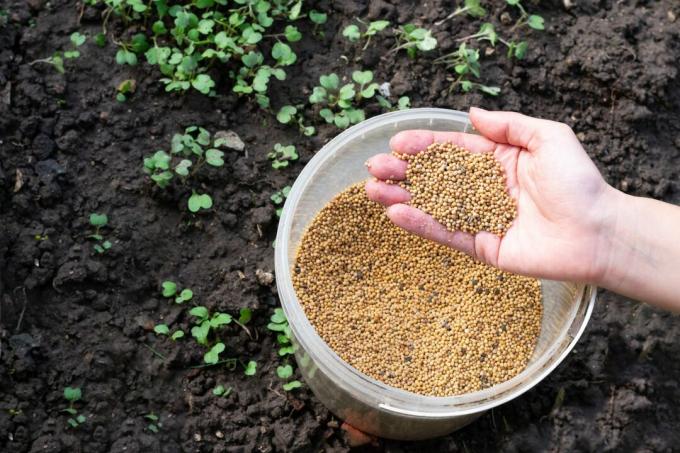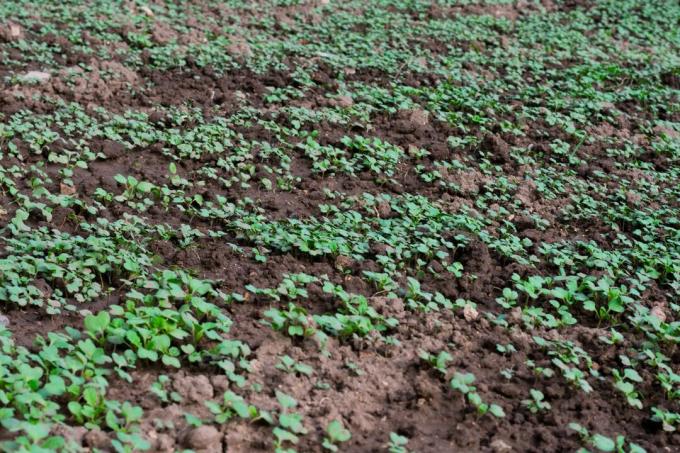Mustard is ideal as a green manure in autumn. In this way, the bed is prepared in the best possible way for the next season. Here you will find everything to do with sowing and using mustard as a crop or as a green manure.

The use of various plants as green manure is enjoying ever greater popularity in domestic gardens. Even mustard is suitable in many ways. How to plant or sow mustard, why it is particularly suitable as a green manure and effectively suppresses weeds, you will find out in this article.
contents
- Planting mustard: location and timing
- Growing mustard: sowing and planting mustard
- Plant mustard as a green manure
- Sow mustard against weeds
Planting mustard: location and timing
There are three types of mustard: the white, brown and black mustard (Sinapis alba, Brassica juncea and Brassica nigra). In principle, mustard can be sown all year round, as long as it is frost-free. The best time is after the ice saints in May until autumn. This applies equally to all three types of mustard. However, if you want to harvest and use the mustard seeds, you should sow them in good time. To do this, you can pre-germinate the mustard plants on the windowsill in early spring and place them in the garden as young plants. If you want to use mustard as a green manure or catch crop, this can happen at any time after the previous fruit has been harvested.
In general, mustard can be grown in any full sun to partially shaded location because it is very undemanding. Ideally, the soil is humic and somewhat calcareous, but mustard can also be used as a soil improver on poor soils. With its strong, deep roots it breaks up soil compaction and brings organic material into deeper soil layers. Almost any other vegetable can be used as a neighbor for mustard, merely a mixed culture with other cruciferous species is not advisable because of a possible disease transmission.
Tip: The space available is also a decisive factor in which variety is ultimately selected. If you have a lot of space, you can easily use the black mustard, which grows up to 200 cm high. Who, on the other hand, is a Green manure If you need catch crops for your raised bed or balcony garden, you should choose the white mustard, which is no more than 70 cm high.
Growing mustard: sowing and planting mustard
If you want to harvest mustard seeds as a spice, proceed as follows: The mustard can be planted or sown.
If mustard seeds are to be sown, the planting distance should be somewhat closer than for young plants, as not all the grains will germinate - preferably 10 to 20 cm. This also protects against losses by birds, as they like to eat the grains.
If you want to plant mustard seeds, you can start doing so from mid-May. The seeds can be placed in loosened soil and then covered with soil about a finger's width. Then the seeds have to be watered well so that they start to germinate. If it is a little drier, it is advisable to water regularly. The first seedlings should be visible after a few days. If the plants have finally germinated and are too dense, some can be removed to give the remaining plants enough space.

Young mustard plants are not commercially available. But if you have already grown small plants around March, you can move them from May with a planting distance of about 15 to 20 cm from each other. To do this, dig a small hole with a flower trowel and put the seedling into it. Then you cover the hole with soil and water the plant well.
The mustard is a fairly undemanding plant during growth, but it should be watered regularly when it is dry. The first leaves can be harvested just three weeks after the plants have sprouted, for example to make a delicious salad.
The seeds grow in pods and are usually ready for harvest in September or October. If you shake the pods and there is a rattle inside, they are ripe and the harvest can begin. To do this, you can simply detach the pods from the plant by hand, open them and shake out the grains. If you have a larger harvest, you can collect everything in a bag and tap it with a rolling pin or your hand to loosen the mustard seeds from the pods.
Mustard plants that have been sown or planted late and do not reach maturity can also be eaten as leafy vegetables. They are therefore a perfect culture for autumn. In Indian cuisine, the mustard herb is used for vegetable dishes similar to spinach.
Summary: growing mustard as a vegetable
- Direct sowing from mid-May or prefer in the house / cold frame / greenhouse from March, then plant out from May
- Water regularly when dry
- Harvest the mustard seeds from September / October
- Mustard that is sown late does not bloom or form seeds, but can be eaten as a leafy vegetable
Tip: If you want to grow mustard in the bucket to harvest the seeds, you should make sure that the plant gets plenty of sun and is well supplied with nutrients and water. For the ideal supply of the plant, a nutrient-rich potting soil is ideal. Our Plantura organic universal soil combines these positive properties and is also made from environmentally friendly and peat-free materials.
Plant mustard as a green manure
The purpose of green manure is to supply the depleted soil with fresh nutrients and organic material after a plant that has become very nutrient-consuming. Green manures can be used both on vegetable patches and in the preparation of lawns or flower beds.
Thanks to its deep roots, the mustard loosens the soil structure and thus improves soil life. Green manure with mustard therefore has a multiple positive effect.
You can sow mustard as a green manure between May and October.
All types of mustard can be used as green manure, the well-known yellow mustard is also suitable as green manure. It should not be sown until late in the year, but ideally immediately after the previous vegetable has been harvested. If the mustard has grown far enough, you can simply cut it off to the ground and leave it on the bed. The best time to do this is before flowering, as no seeds have yet been formed. Otherwise these could sprout again in the next year and disturb the bed. If the mustard is sown very late and has not yet formed any flowers before the first frost, the plant can also stand as a whole and does not have to be cut off. It then freezes to death and remains on the surface by itself. The plants remain on the bed for the entire winter and protect the soil and soil life in this way from severe frost, sun and erosion. In spring, the rotten mustard plants can finally be buried under the ground and provide organic material for building humus.

Attention: Mustard is a cruciferous vegetable. It is suitable as a green manure and catch crop on all areas if none in the previous three years other cruciferous vegetables have been grown and no cruciferous vegetables will be grown for the next three years should. Otherwise there is a risk of disease transmission. So you should definitely pay attention to the crop rotation in your own garden.
Sow mustard against weeds
Due to its diversity, mustard could almost be described as a miracle plant. In addition to the many advantages for soil structure and nutrient balance, it is also very fast-growing. This means that once mustard has sprouted, weeds hardly stand a chance. The mustard grows very quickly and forms a dense soil cover, so that the slower growing weeds are suppressed. Mustard can always be sown in an open field to suppress the weeds. It can no longer overgrow weeds that have already grown tall. These must be weeded by hand in the tried and tested way before sowing.
You last grown cabbage and because of the crop rotation you cannot use mustard as a green manure? Here you will find a selection of different plants that can be used as alternatives Green manure suitable.
